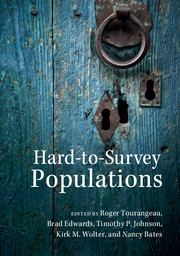Book contents
- Frontmatter
- Dedication
- Contents
- List of figures
- List of tables
- List of boxes
- List of contributors
- Preface
- Part I Introduction
- Part II Conducting surveys in difficult settings
- Part III Conducting surveys with special populations
- Part IV Sampling strategies for the hard to survey
- Part V Data collection strategies for the hard to survey
- 25 Use of paid media to encourage 2010 Census participation among the hard to count
- 26 The hard to reach among the poor in Europe: lessons from Eurostat’s EU-SILC survey in Belgium
- 27 Tailored and targeted designs for hard-to-survey populations
- 28 Standardization and meaning in the survey of linguistically diversified populations: insights from the ethnographic observation of linguistic minorities in 2010 Census interviews
- 29 Mobilizing hard-to-survey populations to participate fully in censuses and surveys
- 30 Finding the hard to reach and keeping them engaged in research
- Index
- References
30 - Finding the hard to reach and keeping them engaged in research
Published online by Cambridge University Press: 05 September 2014
- Frontmatter
- Dedication
- Contents
- List of figures
- List of tables
- List of boxes
- List of contributors
- Preface
- Part I Introduction
- Part II Conducting surveys in difficult settings
- Part III Conducting surveys with special populations
- Part IV Sampling strategies for the hard to survey
- Part V Data collection strategies for the hard to survey
- 25 Use of paid media to encourage 2010 Census participation among the hard to count
- 26 The hard to reach among the poor in Europe: lessons from Eurostat’s EU-SILC survey in Belgium
- 27 Tailored and targeted designs for hard-to-survey populations
- 28 Standardization and meaning in the survey of linguistically diversified populations: insights from the ethnographic observation of linguistic minorities in 2010 Census interviews
- 29 Mobilizing hard-to-survey populations to participate fully in censuses and surveys
- 30 Finding the hard to reach and keeping them engaged in research
- Index
- References
Summary
Introduction
Many types of survey respondents are difficult to access, to locate, and (in longitudinal research) to stay in contact with throughout the course of a study. These types of respondents fall into two main categories. The first category includes people who are difficult to reach by nature, such as young adults whose lives are in transition, the mentally ill, the homeless, and drug users. These population groups are extremely mobile and, in some cases, less likely to maintain close ties with relatives who might serve as a means of locating or contacting them. The second category includes people who are consciously avoiding being located in an attempt to avoid contact with the justice system, immigration authorities, debt collectors, stalkers, or others. People falling into either of these two categories may lack fixed addresses, or be “cell phone only,” with episodic cell service and numbers that change frequently, or list residences or phones in the name of another person.
The hardest subjects to reach in a target population group might provide fundamentally different responses than members of the group who are relatively easier to find and survey (Groves, Fowler, Couper, Lepkowski, Singer, & Tourangeau, 2004). Not including certain segments of a population leads to nonresponse bias, which threatens the quality of survey statistics and the validity and generalizability of research findings (Cottler, Compton, Ben-Abdallah, Horne, & Claverie, 1996). The goal of maximizing power and minimizing potential nonresponse becomes even more difficult when the study population by definition is hard to reach. Researchers face a trifecta of challenges to data reliability when such studies are longitudinal: maximizing power, minimizing systematic nonresponse, and maintaining the respondent pool over time. Tracking efforts can minimize these threats by maximizing participation among sample members (Brown & Nederend, 1997), minimizing nonresponse among respondents with certain characteristics or reflecting sample subpopulations (Teitler, Reichman, & Sprachman, 2003), and reducing subject attrition in research requiring multiple waves of data collection (Cottler et al., 1996).
- Type
- Chapter
- Information
- Hard-to-Survey Populations , pp. 619 - 641Publisher: Cambridge University PressPrint publication year: 2014
References
- 9
- Cited by

